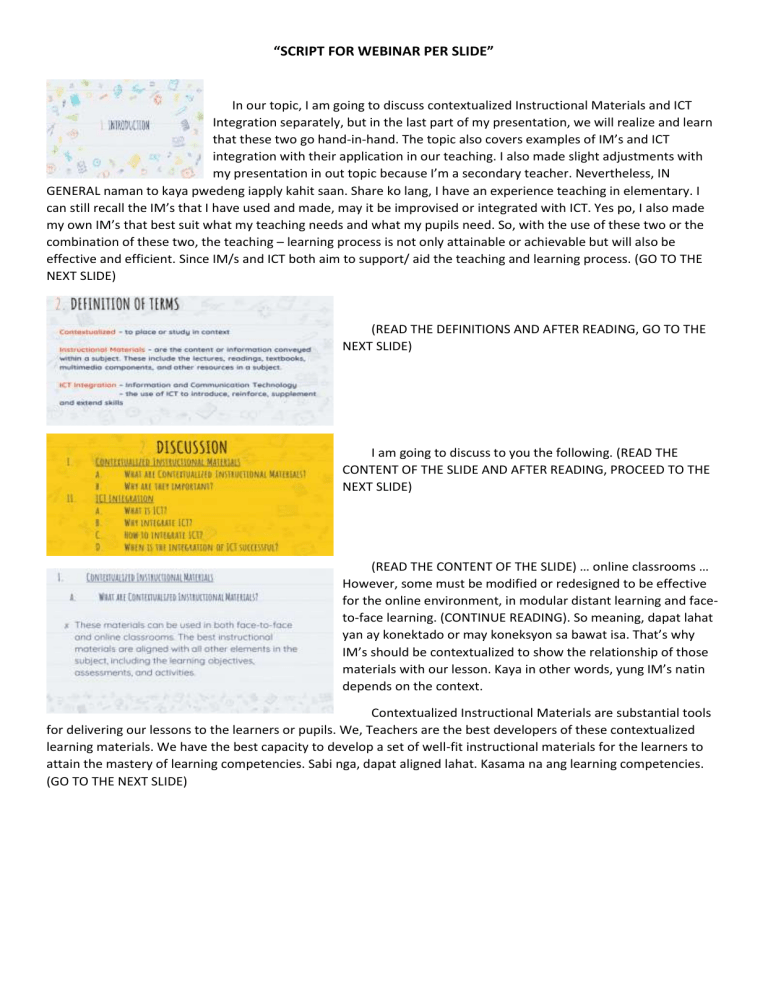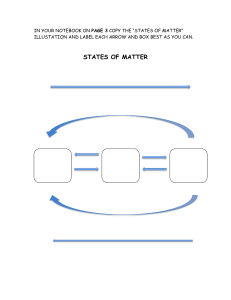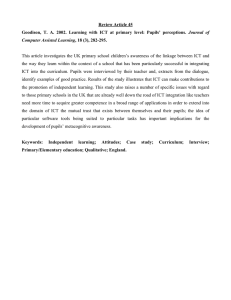
“SCRIPT FOR WEBINAR PER SLIDE” In our topic, I am going to discuss contextualized Instructional Materials and ICT Integration separately, but in the last part of my presentation, we will realize and learn that these two go hand-in-hand. The topic also covers examples of IM’s and ICT integration with their application in our teaching. I also made slight adjustments with my presentation in out topic because I’m a secondary teacher. Nevertheless, IN GENERAL naman to kaya pwedeng iapply kahit saan. Share ko lang, I have an experience teaching in elementary. I can still recall the IM’s that I have used and made, may it be improvised or integrated with ICT. Yes po, I also made my own IM’s that best suit what my teaching needs and what my pupils need. So, with the use of these two or the combination of these two, the teaching – learning process is not only attainable or achievable but will also be effective and efficient. Since IM/s and ICT both aim to support/ aid the teaching and learning process. (GO TO THE NEXT SLIDE) (READ THE DEFINITIONS AND AFTER READING, GO TO THE NEXT SLIDE) I am going to discuss to you the following. (READ THE CONTENT OF THE SLIDE AND AFTER READING, PROCEED TO THE NEXT SLIDE) (READ THE CONTENT OF THE SLIDE) … online classrooms … However, some must be modified or redesigned to be effective for the online environment, in modular distant learning and faceto-face learning. (CONTINUE READING). So meaning, dapat lahat yan ay konektado or may koneksyon sa bawat isa. That’s why IM’s should be contextualized to show the relationship of those materials with our lesson. Kaya in other words, yung IM’s natin depends on the context. Contextualized Instructional Materials are substantial tools for delivering our lessons to the learners or pupils. We, Teachers are the best developers of these contextualized learning materials. We have the best capacity to develop a set of well-fit instructional materials for the learners to attain the mastery of learning competencies. Sabi nga, dapat aligned lahat. Kasama na ang learning competencies. (GO TO THE NEXT SLIDE) (READ THE CONTENT OF THE SLIDE WITH PICTURES) Even though these are somewhat traditional, they are not just used to get the attention of the pupils but also to make our teaching, especially the learning process more engaging. Dahil jan, nahu-hook natin yung mga bata sa ating lesson. Lalo pang, mas nagiging authentic yun learning nila. Halimbawa itong FLASH CARDS, we can use them in any of the subjects in elementary. Let’s use flash cards in the English subject. In teaching our pupils the alphabets, we are going to flash them the cards containing the letters of the alphabets. The pupils will recognize the letters individually, d ba? They can identify what letter is being presented in each card. We should support it by uttering the sounds so that our pupils could clearly recognize and learn the letter, and of course by stating some examples. (GO TO THE NEXT SLIDE) (READ THE CONTENT OF THE SLIDE) That is why selecting IMs is very crucial. We must be careful and aware of what IM’s we are going to use in our lesson. We cannot simply select flashcards if we are going to teach about locations and places. D ba mas appropriate and correct if we are going to use MAPS instead of flashcards? We, teachers should know what are the uses of the different Instructional Materials. Kasi pag hindi akma yung ginamit natin na Instructional Materials, what would happen is, our learners might get bored or lose interest and worse if they might not get what we are trying to teach them. Kaya dapat iwasan nating mangyari yan. This is especially true for online courses, which rely on a thoughtful and complete collection of instructional materials that students will access, explore, absorb, and reference as they proceed in a course. Therefore, such materials must be carefully planned, selected, organized, refined, and used in a subject. The planning and selection of instructional materials should take into consideration both the broadness or wideness and depth of content so that student learning is optimized. (GO TO THE NEXT SLIDE) Over the past years, we’ve seen a continued integration of technology into the curriculum, subjects and lessons, yet what is interest in nowadays is that it is currently being used to transform the educational setting. BUT WHAT EXACTLY DO WE MEAN BY TECHNOLOGY OR ICT INTEGRATION? By infusing ICT into classroom basically means (CLICK DOWN ARROW) using ICT as a tool to enhance learning in a content area or multidisciplinary setting. (CLICK DOWN ARROW) it is intended to allow students to create and demonstrate what has been taught through the use of various applications to express their ideas, thoughts, and learning. (CLICK DOWN ARROW) Students can use technology to learn content and show their understanding of that content, NOT just their expertise with the tool. Remember, our learners are now what we call the “digital natives” where they are born in the age of technology. We could now assume that our pupils are able to surf the internet, navigate applications, and etc. Let’s talk into practical terms. This could take the form of creating podcasts, making movies or even recording songs. The output can then be presented to an authentic audience which can be the classroom and the world if posted, the one which is interested in the topic. By that, our pupils can share their work to the class or the entire world and at the same time, they can receive instant feedback on that work. The internet is therefore allowed learners to connect with others. Adam Bellow of Technology Training Specialists in the USA believes that if a lesson can be presented in a better way, using technology, then digital tools should indeed be used in the classroom. And the Common Core State Standards in the US call for students to develop digital media and technology skills. What made them state those words? It is because we must mold our learners to become globally competitive. So, learners should be given the opportunity to create their own content rather than just absorbing it. (GO TO THE NEXT SLIDE) (READ THE CONTENT OF THE SLIDE) (FROM THE PICTURE) The term Information and Communications Technology is generally accepted to mean all technologies that combined, allow people and organizations to interact the digital world. According to Grabe (2007), ICT has gone through innovations and transformed our society that has totally changed the way people think, work and live. Meaning, ICT has a great impact to us. Some scholars claim that there is really a need of ICT integration in the curriculum. Therefore, teachers are seen as the key players in using ICT in their daily classrooms in preparing students for the current digital era. This is due to the capability of ICT in providing dynamic and proactive teaching-learning environment. Dynamic kasi yung panahon natin ay nagbabago at yung mga teachings natin also require changes that in which we should adapt into. We could not always stick with one technology and apply them into all of our lessons. That is wrong. Kung ang IMs nga binabago natin, therefore in integrating ICT in our instructional materials should also change. (GO TO THE NEXT SLIDE) (READ THE CONTENTOF THE SLIDE) With this in mind, we can focus on why technology should be integrated. (GO TO THE NEXT SLIDE) One of the main reasons is that technology can help learners improve their problem-solving skills especially in problem-solving based learning. (CLICK DOWN ARROW) Students can work together or independently to explore which tool can help them visualize the problem. (CLICK DOWN ARROW) In addition, it can lead to greater learning independence (CLICK DOWN ARROW) as learners work out what Educational Technology tool best expresses their knowledge. (CLICK DOWN ARROW) More importantly, students can work at a pace that suits their needs rather than sticking to what ICT they are knowledgeable with as expected in more traditional classroom setups. Because of this, students can track their progressions through teachers’ feedback by reflecting their own learning. ICT in education improves engagement and knowledge retention: When ICT is integrated into lessons, students become more engaged in their work. This is because technology provides different opportunities to make it more fun and enjoyable in terms of teaching the same things in different ways. (GO TO THE NEXT SLIDE) Let’s turn our attention now to how teachers should actually integrate technology into the educational context. (CLICK DOWN ARROW) Teachers focus on delivering the curriculum appropriately with the support of Education Technology resources. And preparing lessons (CLICK DOWN ARROW) Teachers should not forget that technology is merely a tool for lesson enhancement another guiding strategy in essence technology shouldn’t be used (CLICK DOWN ARROW) unless it is improving what they are already doing. (CLICK DOWN ARROW) we should also need to bear in mind of course, that although technology is all around us, not all students know how to use it. (CLICK DOWN ARROW) And so, we need to update our knowledge and plan our teaching accordingly so to ultimately help our learners. (CLICK DOWN ARROW) Furthermore, if we connect learning tasks to the real world, students become more engaged in their learning as they create the information into something of their own. These simply show that this is farm from the traditional academic model where students are expected to memorize something and then present it for a test. (GO TO THE NEXT SLIDE) Lastly, when is integration of ICT successful? (CLICK DOWN ARROW) Well, it is when ICT is available for the task, (CLICK DOWN ARROW) When it becomes a routine part of our daily lives. (CLICK DOWN ARROW) Meaning, it becomes second nature and not an effort to implement in classroom. (CLICK DOWN ARROW) Thus, teachers don’t worry about what Edtech tools are accessible for the task but (CLICK DOWN ARROW) instinctively use any tool to support the content being covered. Interestingly, researches have shown that the implementation of technology in schools have improved. Possible yan mangyari kasi integration of ICT has created technologically literate learners. This also helps us, teachers to teach our pupils smoothly since they are already aware of technologies unlike noong panahon, talagang nagiging ignorante pa mga students kasi bago palang sa kanila. Ang nangyayari pa, nawawala din yung attention nila sa lesson kasi they are already focusing on the technology that teachers used. Through this, opportunities are given to our pupils their collaboration skills and real-world scenarios since given naman na talagang imaginative ang ating mga learners. Isa pa din if our pupils share what they know to their classmates. Kaya jan, nagiging successful ang ICT integration. Mas lalo pa if our pupils apply what they learned. (GO TO THE NEXT SLIDE) Let me now conclude everything up. Instructional materials and ICT integration really go hand-in-hand. Nagpapakita lamang dito na sa tuwing gumagamit tayo ng IMs at sinamahan pa natin ng ICT, our pupils can learn more. Let’s not simply stick with the teachings inside the textbook. We, teachers should be innovative and creative in how we teach our students. Always remember that choosing IMs are very crucial. Pagdating naman sa ICT integration, we should integrate ICT to back-up the Instructional Materials that we are going to use to our lessons. We know naman na our priority or main objective is yung may malaman or matutunan satin yung ating learners. Since now we’re in a digital area, we must make use of technologies that are around use. If you can still remember in your EdTech subject, it gave us a question na “Is technology boon or bane?” magagaling naman tayong mga teachers pag dating jan sa decision making pwera lang sa love (haha) d ba? Kidding aside, the teaching and learning process is very dependent on what we have decided to do inside the classroom. (GO TO THE NEXT SLIDE)






